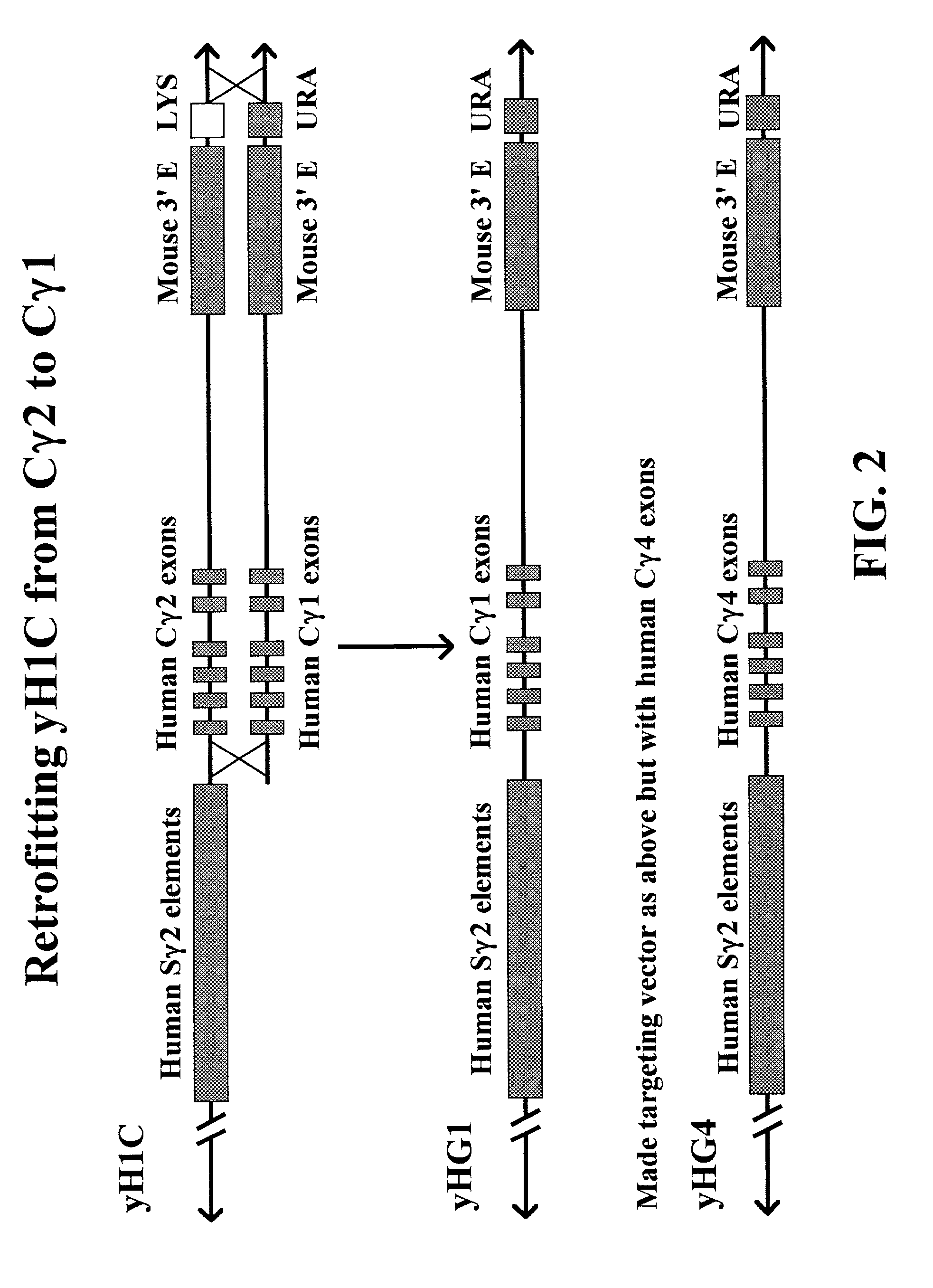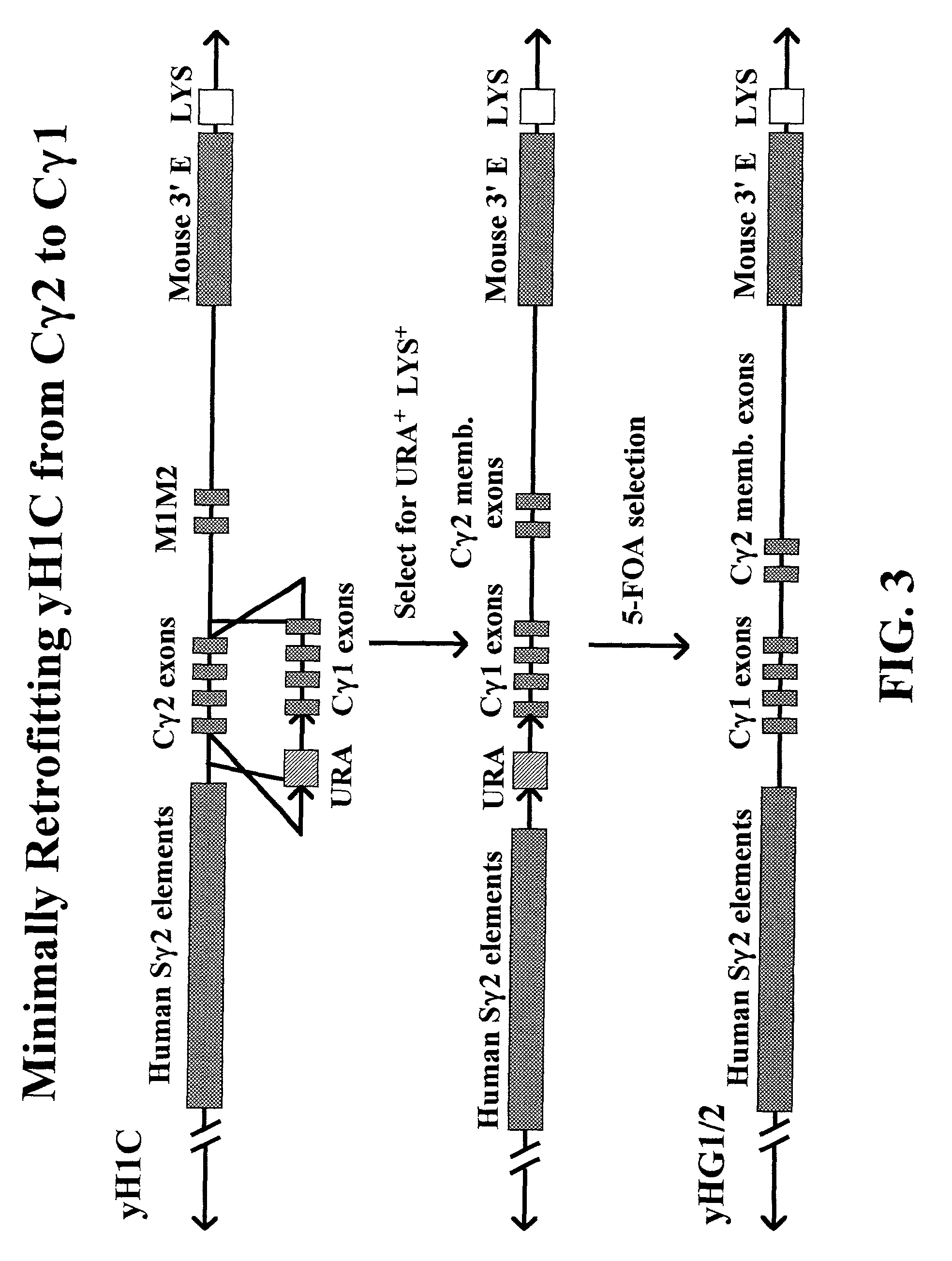Transgenic animals for producing specific isotypes of human antibodies via non-cognate switch regions
a technology of human antibodies and switch regions, which is applied in the direction of fused cells, drug compositions, immunological disorders, etc., can solve the problems of severe allergic reaction, inherent disadvantages of murine mabs, and rendering the therapeutic useless
- Summary
- Abstract
- Description
- Claims
- Application Information
AI Technical Summary
Problems solved by technology
Method used
Image
Examples
example 1
[0132]Yac Vectors for Murine γ1-HUMAN γ4 or Murine γ1-Human γ1
[0133]Replacement vectors for targeting the parent YAC yH1C to replace the human γ2 switch element and human CH γ2 exons with the murine γ1 switch element and either the human Cγ1 exons or the human Cγ4 exons were prepared (FIGS. 1). The vectors were designated as pMuShu1 and pMuShu4 (FIG. 5). The vectors were constructed using a low copy number cloning vector known as pACYC177. This vector pACYC177 is available from New England Biolabs, Inc., Beverly, Mass. and the sequence can be found in Genbank sequence database under the sequence accession number Genebank #X 06402. A low copy number origin of replication is useful to prevent unwanted rearrangements or deletions of the plasmid DNA when propagated in E coli.
[0134]The first step was to introduce a linker into pACYC177 in order to accommodate the elements needed for the targeting vector. The linker contained the following restriction sites: NheI-SalI-SmaI-NotI-EcoRI-Xba...
example 2
[0174]Targeting of γ1 or γ4 Constructs on yH1C YAC
[0175]The TV1 or TV4 vectors (5 ug DNA) were linearized by digestion with the restriction enzyme NotI (FIG. 5). The DNA was purified by phenol extraction followed by phenol / chloroform extraction. Next, the DNA was precipitated with ethanol and then used to a transform a yeast clone containing the yHIc YAC using a LiAc transformation protocol. [See Schiestl, R. H. et al., Curr. Genet. 16,339–346 (1989)]. Transformants were plated onto SC-URA agar media plates and incubated at 22° C. until colonies appeared or approximately 5–6 days. SC-URA plates contain a media for growth of yeast which lacks uracil and therefore selects for yeast colonies that can produce their own uracil. Similarly, SC-LYS plates contain a media for growth of yeast which lacks lysine and selects for yeast colonies that can produce their own lysine. The resulting colonies were repicked onto SC-URA plates and on SC-LYS plates—for genetic testing—to look for the loss ...
example 3
[0197]Construction of Vectors for Retrofitting yH1C YAC to γ1 (TV G1) and γ4 (TV G4)
[0198]Vector construction for preparing the targeting vectors to retrofit the yH1C YAC to yHG1 and yHG4 is schematically shown in FIG. 6. The targeting vectors were built on a backbone of pACYC177 (Genebank #X06402) available from New England Biolabs Inc. (Beverly, Mass.). We introduced a linker into pACYC177 to facilitate cloning of a murine 3′ enhancer. We called the pACYC177 vector containing the linker Int 9. The arrangement of restriction enzyme cloning sites in the linker was as follows: HindIII-SalI-MluI-PacI-FseI-HindIII. The linker nucleotide sequence (SEQ ID NO: 16) is shown below:[0199]5′ agc ttg tcg aca cgc gtt taa tta agg ccg gcc a
[0200]The nucleotide sequence of the complementary strand (SEQ ID NO: 17):[0201]5′ agc ttg gcc ggc ctt aat taa acg cgt gtc gac a
[0202]We cloned the murine 3′ enhancer from the yH1C targeting vector as an approximately 4 kb MluI fragment. The 4 kb enhancer fragm...
PUM
| Property | Measurement | Unit |
|---|---|---|
| density | aaaaa | aaaaa |
| affinity | aaaaa | aaaaa |
| spatial distances | aaaaa | aaaaa |
Abstract
Description
Claims
Application Information
 Login to View More
Login to View More - R&D
- Intellectual Property
- Life Sciences
- Materials
- Tech Scout
- Unparalleled Data Quality
- Higher Quality Content
- 60% Fewer Hallucinations
Browse by: Latest US Patents, China's latest patents, Technical Efficacy Thesaurus, Application Domain, Technology Topic, Popular Technical Reports.
© 2025 PatSnap. All rights reserved.Legal|Privacy policy|Modern Slavery Act Transparency Statement|Sitemap|About US| Contact US: help@patsnap.com



